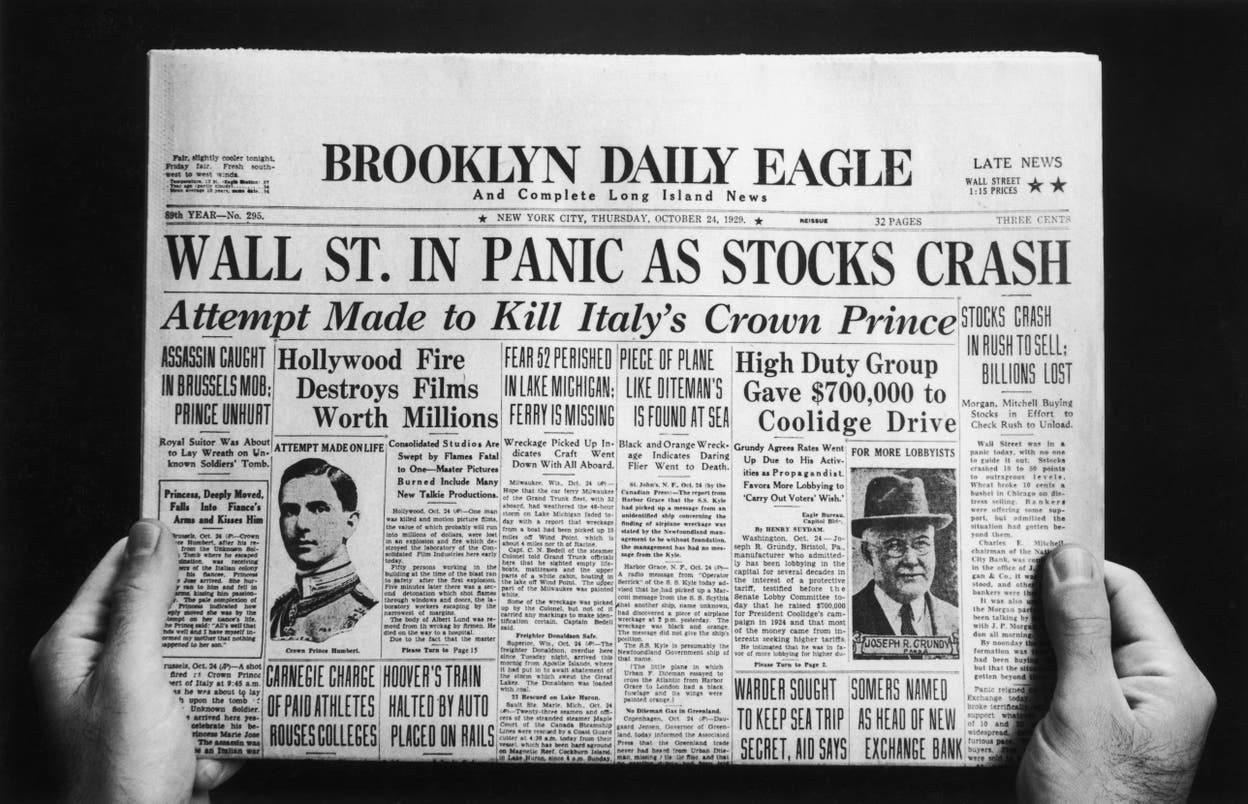A Tuesday Blackened
Country-wide collapse of open-market security values in which the declines established and the actual losses taken in dollars and cents were probably the most disastrous and far-reaching in the history of the Stock Exchange.
Stock Prices Slump $14,000,000,000 in Nation-Wide Stampede to Unload; Bankers to Support Market Today, The New York Times, October 29th, 1929
The market had been falling since Thursday but on Tuesday, October 29th, 1929, the world erupted into chaos. It had nosedived and was careening to the bottom. Investors were sending frantic calls repeatedly to their broker and if they couldn’t get through, they took to the streets. Roads were flooded with investor after investor rushing to their bank to sell, sell, sell. Lines went out the door stretching down the street. The New York Stock Exchange was surrounded by a disgruntled and terrified crowd scared for their livelihoods. The more shares were sold, the quicker prices dropped creating a continuous loop. Their success was tied to that of the market and if it was dropping, they’d have nothing. It was pandemonium.
The Inevitable Crash
In March 1929, doubt was beginning to creep in. A mini-crash had occurred as investors grew scared and started panic selling their stock. Charles E. Mitchell, the Head of National City-Bank, halted the selling by offering a solution. His bank would provide $25 million in credit to prevent the market from sliding any further. The market recovered and money continued to be recklessly thrown out without a care by bankers to anyone who expressed a sliver of interest. That summer, 300 million shares were traded with margin. The market seemed to have a limitless ceiling. Until the crash. On October 29th, the Dow Jones Industrial Average fell by 12% and 16 million shares were traded by investors. All attempting to sell quickly to prevent bigger losses. With the ticker tape lagging hours behind, no one had a clue on how much they were losing. The only sure fact was that they were bottoming out– and quickly.
Step by Step Until the Crash
The day was coined as “Black Tuesday” and its cause was the entirety of everything which happened in the 1920s. Success after success, the ’20s were filled to the brim with excess and continuous achievement. The market went a rapid expansion, everyone was an investor who had hot stock tips to share and the barrier to entry was on the floor. Liberty bonds were being sold and homes were being mortgaged to put more and more cash into the market. The cash deposited was used by investors to buy securities on margin with 10% down and the remaining 90% being supplied by the banker. The belief was they’d earn it back and then some with their initial deposit being doubled and even tripled. Which is where they’d make their fortune. What was hidden was the market manipulation orchestrated behind closed doors: bankers and other high-profile individuals would conspire to buy specific shares low, sell them to investors at a much higher price by proclaiming them as a secure investment, and cash in the profits once sold. The enormous profits drowned out the doubts of those saying it wasn’t sustainable. For the few who tried to sell, they were pushed into keeping their funds in the market longer and buying in even more with the lure of greater profits.
And about October the 4th I went into the National City Bank and asked them to sell out everything…I was surrounded at once by all the salesmen in the place, and made to know that that was a very, very foolish thing to do…I realize that this testimony sounds rather foolish, to think that a man can not go in and say ‘Sell that stock’ and walk out. But it was not as easy as it sounds, because each time I would go to sell it they would call my attention to the fact that it had gone up a couple of points.
Edgar Brown, Testimony of Edgar D. Brown, Pottsville PA., Hearings Before a Subcommittee of the Committee on Banking and Currency United States Senate, February 28th, 1933
Everything is Fine
George Mehales was a successful business owner when he was introduced to the stock market. Recommended to him by a customer, he dived in and his shares immediately began rising. But by the end of his first month, he had lost everything he had put in and more. Forced to sell his cafe at a cheap price, his foray into the market decimated him.
All the money I took in, I put into stocks. The first days of October in 1929 made me feel like I was rich. The stocks I bought had gone up and up…During the last days of October, my stocks began to drop. I was gambling on margin. On that day of October 29, they told me I needed more cash to cover up. I couldn’t get it. I was wiped out that day…that almost killed me…I considered killing myself, ’cause I had nothing left.
George Mehales, December 1938
Mehales’ recollection is one held by many. Life savings were lost and so was the trust. Except for a few individuals who continued to remain optimistic like President Herbert Hoover and Treasury Secretary Andrew W. Mellon. Who assured citizens that the market crash wasn’t affecting businesses outside of it. Once investors stopped reacting with fear, everything would return to normal and the economy would continue to flourish. Which did happen. Up until April 1930, the stock market had recovered impressively quickly and returned to levels as high prior to the crash. But then banks started failing. Stocks began dropping again. Unemployment rates were increasing. This decline paved the way for years of economic hardship which would affect industrialized countries across the globe. The Great Depression had arrived and would continue for a long, tumultuous decade.


Pingback: Inside the Banking Act of 1933: Glass-Steagall - Melissa Nakyeyune